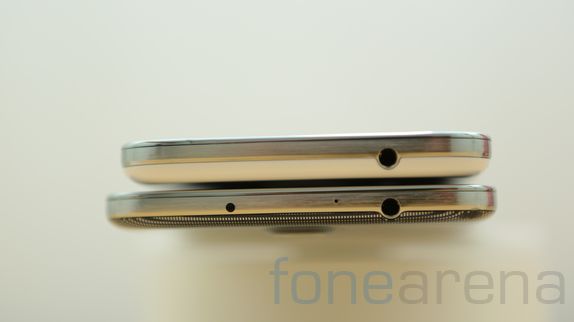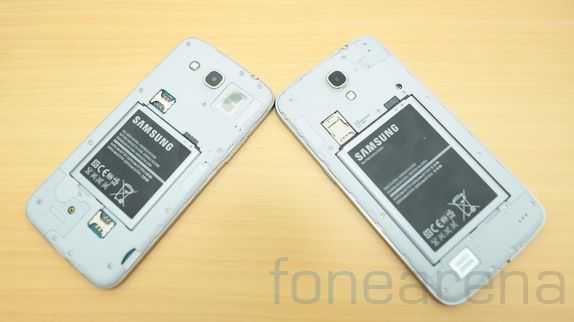Samsung was the first company to push the boundaries of a smartphone beyond 5 inches with their original Galaxy Note featuring a 5.3inch display and thus creating a new brand of devices – “phablets”. The Galaxy Note was a big hit and Samsung followed it up with Galaxy Note 2 having a bigger 5.5inch display. Samsung decided to go beyond 6inches after Huawei’s Ascend Mate with their Mega series.
We brought you the hands-on comparison of both these devices from the Samsung Galaxy Mega India launch event back in May. Here we have the two members of Samsung Galaxy Mega family – the Mega 5.8 and the Mega 6.3. The twins, if you could call them, were launched at the end of May in India at different price points. Both the devices are almost similar in terms of looks except for the size. The internals however are different in both the phablets. Let’s find out which is better.
Design, Build Quality
Even the designers of these phones would find it hard to differentiate the phones if it wasn’t for their size. The Galaxy Mega 6.3 is taller and wider, but thinner than the Galaxy Mega 5.8 and weighs around 17 gram more. Both the devices follow Samsung’s same plastic design pattern with a plastic rim running along the sides of the device. The plastic build helps reduce the weight of the device, but solidity is lost and both the phones are fingerprint magnets.
The positioning of keys and the design language is exactly the same in both devices. On the front of these phones, we have the huge displays and on the top of the display, we have the earpiece at the center and the ambient and proximity sensors are at the right of the earpiece. The 1.9MP front facing camera is located to the right of these sensors. The Mega 6.3 has a notification LED to the left of the earpiece which is missing in the Galaxy Mega 5.8.
On the right side, we have the power lock key which is towards the top in the Mega 5.8, but it is slightly centered in the Galaxy Mega 6.3.
On the bottom, the things are pretty similar with an uncovered micro USB port and a microphone.
On both the devices, we have the volume rocker on the right side. The keys are also made of plastic, but offer nice feedback.
On the top of the Galaxy Mega 5.8, we have the 3.5mm jack alone, whereas the Mega 6.3 has a secondary microphone and IR port in addition to the 3.5mm audiojack.

On the back of these devices, we have the 8MP camera located at the top center along with the LED flash. The LED flash is to the left of the camera on the Mega 5.8 while it is found below the camera in the Mega 6.3. The speaker grill is located right next to the camera in the Mega 5.8, while it is moved to the bottom left corner in the Mega 6.3. Opening the back cover, we see slightly modified internals. The Galaxy Mega 5.8 has two microSIM card slots on top and bottom of the battery and the hot-swappable microSD card slot is at the bottom right side of the device. Things are slightly different on the Galaxy Mega 6.3 because it has only a single microSIM slot. The microSD card is placed exactly over the microSIM slot (a new design to save space) and it works quite well. The microSD card is hot-swappable. However, the SIM is not hot-swappable in both the devices.

Overall, both the devices are pretty similar in look and feel. The Mega 5.8, being the smaller of the two is slightly easier to handle and “relatively” pocketable.
Display
The Samsung Galaxy Mega 5.8 has a 5.8inch qHD display thereby having a pixel density of 190ppi which is pretty low considering the price of the device. The Galaxy Mega 6.3 on the other hand has a 6.3inch HD display with a pixel density of 230ppi which is not the best, but gets the job done. The Mega 5.8 has a normal TFT display while the Mega 6.3 has a SC LCD display thereby giving it an advantage. The refresh rate on the Galaxy Mega 5.8 was pretty low and we could see the trail of the icons even after swiping from one screen to another.
In terms of quality, the display on the Galaxy Mega 6.3 was way ahead with better viewing angles, sharper screen, deeper blacks and better contrast.
Hardware and Performance
The Samsung Galaxy Mega 5.8 is powered by a 1.4GHz dual-core Broadcom BCM28155 along with 1.5GB RAM. The graphics is taken care by Broadcom Videocore IV GPU. The Galaxy Mega 6.3 is powered by a 1.7GHz Snapdragon 400 SoC with two Krait cores, has 1.5GB RAM and graphics is taken care by the Adreno 305 GPU.
In the Galaxy Mega 5.8, out of the 1.5GB RAM, only 1070MB is available and when the device is idle, you get 600MB free whereas on the Galaxy Mega 6.3, out of the 1.5GB RAM, you get 1300MB RAM and when the device is idle, you get 800MB free when the phone is idle.
The Galaxy Mega 5.8 has 8GB internal storage and the user-accessible memory is 5.34GB while the Galaxy Mega has 16GB internal storage and 12.04GB user accessible. Both the devices have a microSD card slot for expansion.
In terms of performance, the Galaxy Mega 6.3 was better and faster in opening apps and switching between applications. In the benchmark, the Galaxy Mega 6.3 scores higher than the Galaxy Mega 5.8.
Camera
The Galaxy Mega 5.8 and Galaxy Mega 6.3 have the same pair of cameras with a 8MP camera at the back and 1.9MP camera at the front. Each of them have a LED flash at the back. The image quality is quite similar and we believe Samsung has used the same camera unit on both the devices.
One thing to differentiate both the phones here is that the Galaxy Mega 5.8 does not have two shooting modes – HDR Mode and Night mode that is there in the Mega 6.3. The rest of the features were pretty similar. The UI is exactly the same and both the devices record videos at Full HD resolution. However, since the Mega 6.3 has a pair of microphones(primary and secondary), it records videos with stereo sound.
You can check out the camera comparison video below to get more understanding about the camera quality of both the phones.
Software features
Galaxy Mega 5.8 and Galaxy Mega 6.3, both being Samsung’s products have the same custom TouchWiz UI on top of them. Underneath, both the devices run on the Android 4.2.2 Jellybean which is the latest version currently.
So you get various features like quick toggles in the notification bar, lockscreen widgets and other under the hood features. Both the devices have Smart Stay and Multi-window feature while the Galaxy Mega 6.3 has NFC, Samsung’s Beam in addition to those features which is missing in the Galaxy Mega 5.8 . In terms of software, the higher priced Mega 6.3 holds a small advantage.
Gaming
Details and texture elements were quite less in the Galaxy Mega 5.8, whereas the games in Mega 6.3 were rich in details. The gameplay was acceptable in Galaxy Mega 5.8 while it was quite smooth in Galaxy Mega 6.3. In Galaxy Mega 5.8, we experienced occasional lags and glitches during the gameplay, but there was no such lag or jitters in the Galaxy Mega 6.3
Battery and Connectivity
The Galaxy Mega 5.8 has a 2600mAh battery while the Galaxy Mega 6.3 has a 3050mAh. The higher number does not essentially indicate a better performance, keep in mind that the Galaxy Mega has to power a bigger and higher resolution display. However, Qualcomm’s Snapdragon 400 SoC in Mega 6.3 is slighly better in terms of power-efficiency than the Broadcom chipset in Mega 5.8. So the battery life is almost similar on both these devices, although we found that the Galaxy Mega 6.3 slightly edged ahead.
In terms of connectivity, the Galaxy Mega 5.8 and Galaxy Mega 6.3 have the usual set of smartphone connectivity features like WiFi, 3G, Bluetooth, GPS, WiFi Direct, DLNA and microUSB. The Galaxy Mega 5.8 has dual SIM capability while the Galaxy Mega 6.3 has NFC.
Conclusion
Overall, both the devices are pretty huge and the first thing to notice would be pocketability. If the big size is not an issue, then the Mega 6.3 should be easy choice. The difference of Rs. 7000 gets you a bigger and better display, a better processor, and a device with more software features.
Advantages of Galaxy Mega 5.8 over Galaxy Mega 6.3
- Relatively Pocketable
- Dual SIM support
- Cheaper price point
Advantages of Galaxy Mega 6.3 over Galaxy Mega 5.8
- Better and bigger display
- NFC
- Better performance
- Better gaming experience
- More software features like Air-View, S-Beam and more